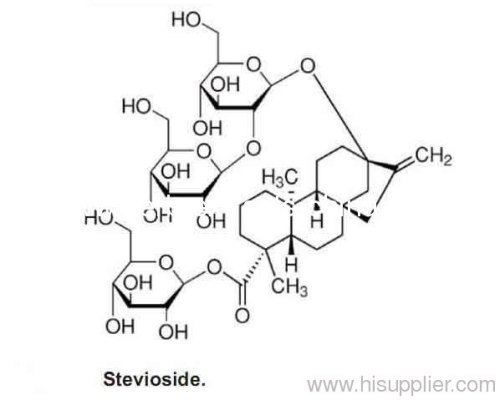Molar mass 318.4504 g/mol | ||
 | ||
Steviol glycosides are the chemical compounds responsible for the sweet taste of the leaves of the South American plant Stevia rebaudiana (Asteraceae) and the main ingredients (or precursors) of many sweeteners marketed under the generic name stevia and several trade names. They also occur in the related species Stevia phlebophylla (but in no other species of Stevia) and in the plant Rubus chingii (Rosaceae).
Contents

Steviol glycosides from Stevia rebaudiana have been reported to be between 30 and 320 times sweeter than sucrose, although there is some disagreement in the technical literature about these numbers. They are heat-stable, pH-stable, and do not ferment. Additionally, they do not induce a glycemic response when ingested, thus making them attractive as natural sugar substitutes for diabetics and other people on carbohydrate-controlled diets. The acceptable daily intake (ADI) for steviol glycosides, expressed as steviol equivalents, has been established to be 4 mg/kg body weight/day.

Structure

These compounds are glycosides of steviol, a diterpene compound. Specifically, their molecules can be viewed as a steviol molecule, with its carboxyl hydrogen atom replaced by a glucose molecule to form an ester, and a hydroxyl hydrogen with combinations of glucose and rhamnose to form an acetal.
The steviol glycosides found in S. rebaudiana leaves, and their weight percentage, include:

The last three are present only in minute quantities, and rebaudioside B has been claimed to be a byproduct of the isolation technique. A commercial steviol glycoside mixture extracted from the plant was found to have about 80% stevioside, 8% rebaudioside A, and 0.6% rebaudioside C.
The Chinese plant Rubus chingii produces rubusoside, a steviol glycoside not found in Stevia.

Stevioside and rebaudioside A were first isolated in 1931 by French chemists, Bridel and Lavielle. Both compounds have only glucose subgroups: stevioside has two linked glucose molecules at the hydroxyl site, whereas rebaudioside A has three, with the middle glucose of the triplet connected to the central steviol structure.
Early sensory tests led to claims that rebaudioside A was 150 to 320 times sweeter than sucrose, stevioside was 10 to 270 times sweeter, rebaudioside C 40 to 60 times sweeter, and dulcoside A 30 times sweeter. However, a more recent evaluation found rebaudoside A to be about 240 times sweeter, and stevioside about 140 times. Rebaudioside A also had the least bitterness and aftertaste. The relative sweetness seems to vary with concentration: a mix of steviol glycosides in the natural proportions was found to be 150 times sweeter than sucrose when matching a 3% sucrose solution, but only 100 times sweeter when matching a 10% sucrose solution.
Biosynthesis
In Stevia rebaudiana, the biosynthesis of the glucosides occurs only in green tissues. Steviol produced in the plastids and in the endoplasmic reticulum is glucosylated and glycosylated in the cytoplasm, catalyzed by UDP-glucosyltransferases. Rebaudioside A, in particular, is formed from stevioside. The glycosides are then stored in vacuoles.
